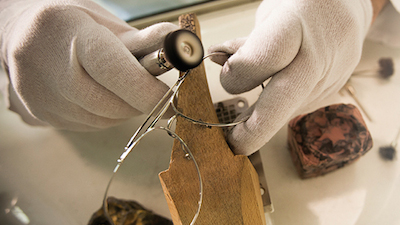SAN FRANCISCO – Even with the current geopolitical climate, now is a good time to invest in luxury brands, according to an executive from Investindustrial, the owner of Aston Martin and Sergio Rossi.
Italian craftsmanship has a strong identity and heritage, which has remained within the country thanks to a lack of globalization. However, as more international companies look to take advantage of the Made in Italy cachet, Italy is at risk of losing its skilled labor to foreign brands.
“If you look at the long-term trends, uniqueness, skills are becoming rarer and rarer,” said Andrea Bonomi, founder and managing principal at Investindustrial. “So these kind of assets are few and far between, and they will recover as soon as this period of indecision passes, we will be back in a normal economic environment.
“And we are concentrating within the luxury space on the non-fashion end of the spectrum,” he said. “The manufacturing skills, the history, the uniqueness of the brand is the key driving factor rather than courting the right timing from a design point of view.”
Back to basics
Eyewear is simultaneously a beauty, fashion and healthcare product, going from something that was at one time a strictly medical device to a statement of personal style. With two-thirds of the world’s population requiring corrective lenses, eyewear has tremendous growth opportunity.
Over the years, more luxury brands have embraced eyewear with licensing deals, with eyewear manufacturer Safilo recently inking a deal with couturier Elie Saab. For this collaboration, Safilo’s CEO Luisa Delgado explained the company is returning to more traditional methods of producing eyewear, taking it back to handcraftsmanship.
Overall, Safilo is focusing on its people and soft skills, getting back to its roots in 1878 as the first artisan eyewear manufacturer to create differentiation between themselves and competitors. It had also been a first mover to mechanize parts of the production process while leaving some of the handwork in tact, allowing it to generate larger volumes.
Safilo has reshored its manufacturing from China to Italy’s Padua Valley, particularly for the luxury fashion labels. This move has required it to be more innovative when producing SKUs for its “mass cool” brands, which can retail for under 100 euros.
Thomas Chauvet, head of European luxury goods equity research at Citi, said that he sees a need for brands to adjust their business practices. The double-digit growth that the industry saw for years has been replaced by numbers that will not extend past 5 percent.
Brands have cut back on their rapid bricks-and-mortar expansion as consumers are becoming more price conscious and other economic factors, including currency shifts, are making for a challenging market.
Millennials are also presenting problems for luxury, since they tend to have less disposable income than previous generations did at their age. Aside from their wallet size, technology and ecommerce has made them more conscious of price differences around the world.
Ms. Delgado said that for the mid-tier luxury brands in Safilo’s stable, the group is focusing on pulling back distribution, creating more of an exclusivity surrounding the high price points.
For Aston Martin, retaining exclusive distribution is not a question. Rather than opening up sales to anyone, consumers have to be in a black book to get access.
This tight distribution does not hurt the brand’s business. When Aston Martin revealed its new concept car developed in collaboration with Italian coachbuilder and design house Zagato at Concorso d’Eleganza Villa d’Este, all 100 cars for this production year were sold in a day (see story).
Talent search
Luxury goods are reliant on skilled craftsmanship, but talent cultivation has proved difficult in today’s culture as consumers readily move away from traditional artisan work.
In the “Underwriting the Future” panel session at the International New York Times Luxury Conference April 6, senior executives from three brands discussed how their business models have cultivated talent in ways that maintain tradition and quality and, importantly, supports the surrounding community. The roots of these talent measures start with training and education to teach employees a useful skill set not just as a form of employment, but for a viable career (see story).
In addition to organizations and private investors lending their support to Italian artistry, companies are also rolling out initiatives to train the next generation of craftsmen.
Safilo is scouting out new design talent through a mentorship program in partnership with Vogue Italia and L’Uomo Vogue.
“A Forward Vision for Eyewear Heritage” claims to be the first tutoring project of its kind dedicated to the tradition and craftsmanship of eyewear. The three winners will have the chance to experience the inner workings of Safilo, which produces the eyewear for licensees including Dior, Jimmy Choo and Givenchy (see story).
“We made a definite and very strong commitment to say we will ensure into our plants and into Italy specifically but not only, our production, but it will not be charity,” Safilo’s Ms. Delgado said. “We have to deserve it and we have to be competitive, and that led to a whole reinvention that is underway painfully but fast of manufacturing to world-class manufacturing standards.
“And for a company that was for the past 50 years was a bit the beauty asleep and made literally zero investments in manufacturing, that has been a whole revival of how to design manufacturing using a modern philosophy but not only, and…putting people, skills, a school, apprenticeship at the core to be able to make sure that we can sustain manufacturing and reshoring, both from a cost as well as from a skill over time perspective.”
from Apparel and accessories – Luxury Daily https://www.luxurydaily.com/capital-assists-fight-to-retain-artisan-skills-says-invest-industrial-founder/
via Your #1 Source to Finding Luxury & Designer Goods, Handbags & Clothes at or Below Wholesale: Click Here.



No comments:
Post a Comment